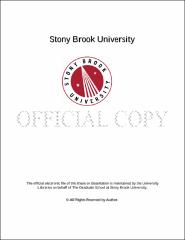| dc.identifier.uri | http://hdl.handle.net/11401/76366 | |
| dc.description.sponsorship | This work is sponsored by the Stony Brook University Graduate School in compliance with the requirements for completion of degree. | en_US |
| dc.format | Monograph | |
| dc.format.medium | Electronic Resource | en_US |
| dc.language.iso | en_US | |
| dc.publisher | The Graduate School, Stony Brook University: Stony Brook, NY. | |
| dc.type | Dissertation | |
| dcterms.abstract | In this study, nanofibrous based membranes were designed, fabricated, characterized and then evaluated for ethanol dehydration in terms of flux, separation factor and energy efficiency. The developed pervaporation (PV) membranes comprise of a barrier layer and a thin-film nanofibrous composite (TFNC) as the supporting scaffold. The TFNC scaffold consisted of three layers: an ultra-fine cellulose nanofibrous (CN) layer, a polyacrylonitrile (PAN) electrospun nanofibrous mid-layer and a polyethylene terephthalate (PET) nonwoven microfibrous bottom layer. The TFNC scaffold had high bulk porosity (up to 80% on electrospun nanofibers) and high surface to volume ratio, and formed a fully interconnected pore structure with 52% - 80% of pressure drop from the similar class of commercial membranes. The nanofibrous scaffold also provided lower transport resistance and minimized the Kundson diffusion behavior for pervaporation (PV). A barrier layer of polyvinyl alcohol (PVA) cross-linked by fumaric acid, was coated on TFNC to form a PV membrane, which showed superior performance during evaluation for ethanol dehydration, when compared with the same conventional PV membranes with cross-linked PVA barrier layer. The ethanol dehydration results of this new class of PV membranes under varying operating conditions were also investigated. Another type of barrier layer based on multilayered grapheme oxide (GO), was deposited onto the TFNC scaffold to form a high flux PV membrane, by taking advantage of the unique property of GO sheets. The ethanol dehydration experiments showed that the permeate flux doubled and the separation factor quadrupled, compared to commercial (PVA)-based membranes. The morphology of the GO-TFNC membranes and the mechanism of water transport in the GO layer were also elucidated. Further modification of GO was achieved by using an optimal amount of borate to cross-link GO and thereby to stabilize GO. This treatment could improve the thermal stability without affecting the permeability due to the interplay between the enlarged nanocapillary and the reduced hydrophilicty of the GO layer. Both PVA-TFNC and GO-TFNC membrane systems showed promise for possible replacement of the expensive distillation step in the commercial fermentation ethanol production process. | |
| dcterms.available | 2017-09-20T16:50:07Z | |
| dcterms.contributor | Mahajan, Devinder | en_US |
| dcterms.contributor | Chu, Benjamin | en_US |
| dcterms.contributor | S. Hsiao, Benjamin | en_US |
| dcterms.contributor | Kin, Tae Jin | en_US |
| dcterms.contributor | Gupta, Ashutosh. | en_US |
| dcterms.creator | Yeh, Tsung-Ming | |
| dcterms.dateAccepted | 2017-09-20T16:50:07Z | |
| dcterms.dateSubmitted | 2017-09-20T16:50:07Z | |
| dcterms.description | Department of Materials Science and Engineering. | en_US |
| dcterms.extent | 168 pg. | en_US |
| dcterms.format | Application/PDF | en_US |
| dcterms.format | Monograph | |
| dcterms.identifier | http://hdl.handle.net/11401/76366 | |
| dcterms.issued | 2015-08-01 | |
| dcterms.language | en_US | |
| dcterms.provenance | Made available in DSpace on 2017-09-20T16:50:07Z (GMT). No. of bitstreams: 1
Yeh_grad.sunysb_0771E_11614.pdf: 5149083 bytes, checksum: 215dd4bc15094598b744f56259af58a3 (MD5)
Previous issue date: 2013 | en |
| dcterms.publisher | The Graduate School, Stony Brook University: Stony Brook, NY. | |
| dcterms.subject | Materials Science | |
| dcterms.subject | cellulose, composite materials, electrospinning, graphene oxide, membrane, nanofiber | |
| dcterms.title | Energy Efficient Ethanol Dehydration Using Nanofiborus Based Membranes | |
| dcterms.type | Dissertation | |

